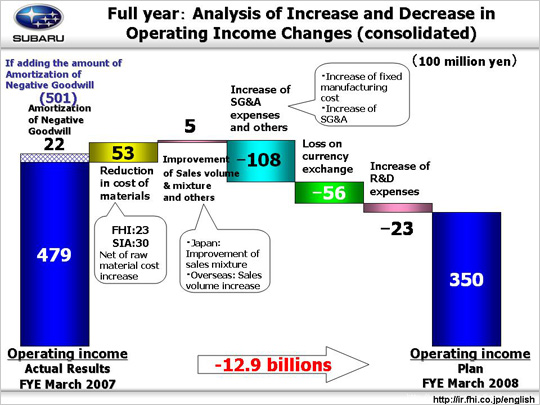
| Next is an explanation for the causes of increasing and decreasing factors, and which reduce the operating income from 47.9 billion yen to 35.0 billion yen. 5.3 billion yen of reduction in cost of materials will be cause an increase for the income, with 2.3 billion yen from FHI, and 3.0 billion yen from SIA. Included in this reduction is about an 8.0 billion yen of raw material cost increase seen, due to steel material shortages and other materials such as aluminum and precious metal worsened market conditions. Improvement of sales volume and mixture add 0.5 billion yen to the income. This is broken down into three parts. (1) In Japan, 0.5 billion yen greater income is expected from an improved sales mixture due to an increased number of passenger cars. (2) A 3.9 billion yen reduction overseas. Despite a quantity increase, the mixture is expected to deteriorate. (3) Inventory adjustments, etc. contributes 3.9 billion yen {unrealized inventory +2.3 billion yen (Japan –2.0 billion yen, overseas +4.3 billion yen), increased income of the 3 companies and other items +1.6 billion yen}. On the other hand, as to the causes for reduced income, first is -10.8 billion yen from increase of SG&A expenses and others. This is broken down into four parts. First, (1) -8.9 billion yen from increased fixed manufacturing cost (-8.9 billion yen by FHI, zero by SIA), there are increased outsourced die procuring cost (-4.6 billion yen) and increased fixed processing cost (-4.3 billion yen) at FHI, whereas at SIA, increased outsourced die procuring cost (-1.8 billion yen) generates a reduced income, which is just compensated for by reduced depreciation expense (+1.3 billion yen) and other items (+0.5 billion yen). (2) 2.0 billion yen lower income from increased SG&A expenses. In Japan, about a 2.0 billion yen increase, with (-0.5 billion yen) from FHI, (-1.2 billion yen) from the dealerships and others, along with increased SG&A associated with new vehicle launching. Whereas, in overseas, SOA (+1.4 billion yen) plans to reduce incentives by $200 per vehicle compared with last year’s {$27M ($1,800 to $1,600)}, on the other hand increased advertising costs (-$6M) associated with new vehicle launching, and higher development expenses (-$9M) associated with strengthening for the sales network, etc., which total to over 1 billion yen of increased income, but other overseas subsidiaries increase SG&A expenses, decreasing income to almost zero. (3) 2.1 billion yen reduced costs associated with accrued warranty claims income. (4) The remaining 2 billion yen income reduction is by other items. Foreign exchange differences cause 5.6 billion yen reduction of income. About a 2 yen stronger rate against the US dollar causes 4.4 billion yen reduction. About a 3 yen stronger rate against the Canadian dollar causes -0.6 billion yen decrease through the export from FHI to Canada. About a 5 yen stronger rate against the Euro causes 0.6 billion yen loss. Increase of R&D expenses reduces the income -2.3 billion yen (50.7 billion yen to 53.0 billion yen). This is due to higher R&D from the planned introduction of a full model change car in each year from this year and on for one car model: Impreza, Forester, and Legacy, etc. The above items in total decrease the operating income by 12.9 billion yen. |